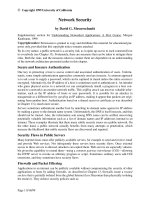New PersPectives oN regulatioNedited by David Moss & John Cisternino.New PersPectives oN pptx
Bạn đang xem bản rút gọn của tài liệu. Xem và tải ngay bản đầy đủ của tài liệu tại đây (3.17 MB, 165 trang )
New
PersPectives
oN regulatioN
edited by David Moss & John Cisternino
New
PersPectives
oN regulatioN
New
PersPectives
oN regulatioN
is work is distributed under a Creative Commons Attribution–Noncommercial–
No Derivative Works 3.0 license. Readers are free to share, copy, distribute, and
transmit the work under the following conditions: All excerpts must be attributed
to: Moss, David, and John Cisternino, eds. New Perspectives on Regulation.
Cambridge, MA; e Tobin Project, 2009. e authors and individual chapter
titles for all excerpts must also be credited. is work may not be used for
commercial purposes, nor may it be altered, transformed, or built upon without
the express written consent of the Tobin Project, Inc. For any reuse or distribution,
the license terms of this work must always be made clear to others: the license
terms are available at />Copyright © 2009 e Tobin Project, Inc.
All rights reserved. For information address
e Tobin Project, One Mifflin Place, Cambridge, MA 02138.
First Edition
10 9 8 7 6 5 4 3 2 1
Printed in the United States of America
is book is set in Adobe Caslon Pro.
Text design by Kristen Argenio/Ideal Design Co.
ISBN 978-0-9824788-0-6 (paperback)
Library of Congress Cataloging-in-Publication Data on file.
Visit www.tobinproject.org
Contents
5
Mitchell Weiss
7
David Moss and John Cisternino
11
Regulation and Failure
Joseph Stiglitz
25
e Case for Behaviorally Informed Regulation
Michael S. Barr, Sendhil Mullainathan, Eldar Shafir
63
From Greenspan’s Despair to Obama’s Hope: e Scientific
Basis of Cooperation as Principles of Regulation
Yochai Benkler
87
Government as Risk Manager
Tom Baker and David Moss
111
Toward a Culture of Persistent Regulatory Experimentation
and Evaluation
Michael Greenstone
127
e Promise and Pitfalls of Co-Regulation: How Governments
Can Draw on Private Governance for Public Purpose
Edward J. Balleisen and Marc Eisner
151
e Principles of Embedded Liberalism: Social Legitimacy
and Global Capitalism
Rawi Abdelal and John G. Ruggie
163
Preface 5
New Perspectives
on Regulation
New research in the social sciences has yielded insights with important (but, as
yet, largely unrecognized) implications for the government’s role in the economy.
is new research holds the promise of enabling creative solutions to pressing
problems. As the financial crisis unfolds and the global recession continues, the
need to share these ideas beyond academia to inform policymaking and public
debate has grown ever more urgent.
To this end, in the fall of 2008 the Tobin Project approached leading scholars
in the social sciences with an unusual request: we asked them to think about
the topic of economic regulation and share key insights from their fields in a
manner that would be accessible to both policymakers and the public. Because
we were concerned that a conventional literature survey might obscure as much
as it revealed, we asked instead that the writers provide a broad sketch of the
most promising research in their fields pertaining to regulation; that they identify
guiding principles for policymakers wherever possible; that they animate these
principles with concrete policy proposals; and, in general, that they keep academic
language and footnotes to a minimum.
As if this weren’t a tall enough order, we asked these scholars for one more
thing: because the need for informed debate on our nation’s problems is so great
and the prospect of important new government action imminent, we asked that
they prepare this new kind of essay on a compressed timeline measured in weeks
rather than the many months or even years that traditional academic writing
usually requires.
Fortunately, a group of leading scholars took up this challenge. is book
is the product of their efforts, for which we are enormously grateful. In seven
chapters, they condense lessons of a broad and varied swath of research and share
insights for how we might address the financial crisis, ensure more enduring
prosperity, and improve our regulatory institutions.
New Perspectives on Regulation is aimed primarily at citizens and public ser-
vants, including our leaders in Washington, who are grappling with a crisis that
conventional approaches didn’t predict and don’t yet seem able to solve. But the
breadth and accessibility of the work should also make it an excellent starting
6 Weiss
point for both students and scholars desiring a survey of the state of the art in
the social sciences, particularly as it relates to public policy.
As an experiment in reconnecting academia to our broader democracy, New
Perspectives on Regulation is one piece of the mission that the Tobin Project’s
affiliated scholars have undertaken: to invigorate public policy debate by rededi-
cating their academic work to the pursuit of solutions to society’s great problems.
Mitchell Weiss
Executive Director
e Tobin Project
Introduction 7
Introduction
David Moss and John Cisternino
Regulation is suddenly back in fashion. After more than thirty years of dereg-
ulation being all the rage, the financial crisis of 2007 to 2009 has dramatically
changed attitudes about the proper role of government. e market fundamen-
talism that drove far-reaching deregulation now looks more like a passing fad
than the classic staple of political economy it was advertised to be.
At the same time, current thinking about regulation may not be as fresh
as its promoters imagine, based to a large extent on ideas that were in vogue
back in the 1960s. Market failure theory was then in its heyday. Every college
student taking Econ 101 learned that although rational individuals typically
maxi mized the welfare of the whole society simply by pursuing their own self-
interest, Adam Smith’s invisible hand occasionally (and sometimes spectacularly)
broke down. A factory, for example, might spew too much smoke into the air
if its owners did not have to bear the costs of the resulting pollution. Concern
about “negative externalities” of this sort became a powerful justification and
driver of environmental regulation. And this was just one piece of a larger whole,
since market failure theory was used to justify a wide range of government
interventions, from antitrust law to social insurance.
Market failure theory encompasses a powerful set of ideas, and it will inevi-
tably remain a pillar of any modern approach to regulation. But it should not be
the only—nor perhaps even the principal—intellectual foundation for a new era
of regulatory engagement. Since the 1960s, influential new research on govern-
ment failure has helped to drive the movement for deregulation and privatization.
Yet even as the study of government failure was flourishing, some very different
ideas were sprouting in the social sciences with profound implications for our
understanding of human behavior and the role of government. Some of these
ideas, particularly from the field of behavioral economics, have begun to nudge
their way into discussions of regulatory purpose, design, and implementation.
Yet even here, the process is far from complete; and many other exciting new
lines of research—on everything from social cooperation to co-regulation—
have hardly been incorporated at all.
Now that many lawmakers and their constituents have apparently concluded
that the earlier focus on government failure went too far, it is imperative that
8 Moss and Cisternino
they be able to draw on the very latest academic work in thinking anew about
the role of government. is, at root, is the purpose of this book: to make the
newest and most important research accessible to a broad audience, expanding
our conception of both the possibilities and the potential pitfalls of economic
regulation at a time of great turmoil in the global economy.
e seven chapters that follow offer seven different perspectives on the subject:
• Marketfailureperspective.Joseph Stiglitz gets things started in chapter 1
with a new look at market failure, which he suggests may be far more
extensive—and more damaging—than generally believed.
• Behavioralperspective. In chapter 2, Eldar Shafir, Sendhil Mullainathan,
and Michael Barr move beyond market failure, showing how a better
under standing of the limits of individual rationality can inform better reg u-
lation—to protect consumers (against “teaser rates” in subprime mortgages,
for example) and to ensure that markets reward producers who make us
better off rather than exploit our limitations.
•Cooperativeperspective.In chapter 3, Yochai Benkler suggests that
self-interest is only a relatively small part of what drives human behavior,
and he explores how successful experiments in social cooperation (in the
collective production of Wikipedia, for example) can serve as a guide for
the structuring and regulation of economic activity.
• Riskmanagementperspective.Tom Baker and David Moss highlight the
government’s critical role as a risk manager in chapter 4; they reveal this
as one of government’s most important and successful functions (in poli-
cies ranging from Social Security to the FDIC) and, importantly, lay out
the basic dos and don’ts of public risk management.
•Experimentalperspective.Michael Greenstone argues in chapter 5
that we can dramatically strengthen regulation of all kinds by building
experimentation into the process of policymaking, developing a culture of
testing (modeled after medical drug and device testing) that privileges
empirical evidence over theory in the making of regulatory policy.
• Co-regulationperspective. In chapter 6, Ed Balleisen and Marc Eisner
take up the fascinating (and highly controversial) subject of co-regulation,
drawing on a growing international literature to show how best to harness
private industry in regulating itself and, at the same time, providing a clear
set of criteria for when government-monitored self-regulation is most likely
to succeed or fail.
Introduction 9
• InternationalPerspective. Finally, in chapter 7, Rawi Abdelal and John
Ruggie adopt an international perspective, demonstrating the importance
of seeing regulation as part of a larger societal bargain, in which citizens
accept the risks and impositions of globalization in return for a degree of
social security and a sense of shared values at home.
Although regulation is now back in fashion (at least for the time being), the
success or failure of regulatory reform will ultimately be decided by substance
rather than style. Policymakers must have access to the very best ideas; and they
could soon find themselves on the defensive if they have to rely exclusively
on the same ones that their predecessors depended on thirty or more years ago.
Fortunately, in the intervening years, scholars have developed new ways of
thinking about regulation—new perspectives that we hope will make a positive
difference, helping to strengthen policymaking at this critical moment in the
life of the nation.
Regulation and Failure 11
Regulation and Failure
Joseph Stiglitz
Only under certain ideal circumstances may individuals, acting on their own,
obtain “pareto efficient” outcomes, that is, situations in which no one can be
made better off without making another worse off. ese individuals involved
must be rational and well informed, and must operate in competitive market-
places that encompass a full range of insurance and credit markets. In the absence
of these ideal circumstances, there exist government interventions that can
potentially increase societal efficiency and/or equity.
Some of the major elements of these interventions are by now well accepted:
antitrust laws, to prevent the creation of monopoly power and/or its abuse; con-
sumer protection legislation, designed especially to address potential problems
of exploitation arising from information asymmetries; and regulations to ensure
the safety and soundness of the banking system, which are made necessary by
systemic externalities (spillover effects of economic transactions affecting many
people who were not parties to the transactions) that can arise when a “systemi-
cally” important institution fails, or is allowed to fail.
e current economic crisis has highlighted the need for government inter-
vention in the event of the failure of a systemically important institution. But
the need for massive intervention implies, in turn, the need to take actions to
prevent the occurrence of such failures in the first place. Sometimes the damage
done by actions that have adverse effects on others can be compensated for after
the fact, but in the cases at hand, this is in general not possible. Policy interven-
tions should be designed to make less likely the occurrence of actions that
generate significant negative spillovers, or externalities.
But these are not the only reasons for government intervention. Markets
fail to produce efficient outcomes for a variety of other reasons that economists
have explored over the last twenty-five years. Markets are plagued by problems
of information asymmetries, and there are incentives for market participants
both to exploit and to increase these information asymmetries. For a variety of
reasons key markets (such as those for insurance against some of the important
risks that individuals and firms face) are missing. (Risk management is the
principal subject of chapter 4 of this volume.)
12 Stiglitz
Even when markets are efficient, they may fail to produce socially desirable
outcomes. e wealthy and powerful may “exploit” others in an “efficient” way:
the gains to one are offset by the losses to others, and in traditional economic
parlance, so long as that is the case, markets are efficient. No one can be made
better off without making someone else worse off. But such outcomes are socially
unjust, and unacceptable. Governments impose regulations to prevent such
exploitation and to pursue a number of other social goals.
ese interventions take a variety of forms. Some are more intrusive than
others. Some are more robust than others; that is, they can withstand attempts
at circumvention. In recent decades, policy has focused on the design of pack-
ages of intervention that are robust, recognizing that the costs of the failure of
intervention are typically on an order of magnitude greater than the costs of the
interventions themselves. In financial markets, interventions include: (a) dis-
closure of information; (b) restrictions on incentive schemes (including conflicts
of interest); (c) restrictions on ownership; (d) restrictions on particular behaviors;
and (e) taxes designed to induce appropriate behaviors.
In addition, there are interventions to ensure competition. One of the big
failures that the recent global financial crisis has exposed is that we allowed
financial institutions to grow “too big to fail.” Not only may such large institu-
tions be able to exploit market power, but they also pose systemic risk to the
economy and have perverse incentives that encourage such behavior. Institutions
that grow too big to fail inevitably know that if they undertake high-risk activi-
ties and fail, government will pick up the pieces, but if they succeed, they walk
away with the gains.
While regulation has typically focused on preventing “harmful” behaviors,
there are some regulations that encourage “constructive” behaviors. ese include
CRA (Community Redevelopment Act) lending requirements, designed to
ensure that there is a certain flow of credit to underserved communities.
Some interventions combine traditional equity concerns with market
failures: governments may encourage private provision of retirement insurance
(recognizing the social consequences of old-age poverty), but also recognize the
abuses that may arise, unless there are restrictions to ensure that ordinary work-
ers are treated symmetrically with management. Again, this crisis has exposed a
regulatory failure: regulators failed to prevent the exploitation of poor and
poorly educated borrowers by lenders. ese people were not able to ascertain
well the risks associated with various lending provisions, such as variable-rate
mortgages with negative amortization, in a period in which interest rates were
at a historically low level. e lenders should, of course, have been able to do a
better job of risk assessment, but because of another set of market failures, they
Regulation and Failure 13
did not. e result is a massive social and economic disaster: people are losing
their homes and their life savings, and our economy is facing a meltdown.
By its nature, a regulation restricts an individual or firm from doing what it
otherwise would have done. ose whose behavior is so restricted may complain
about, say, their loss of profits and potential adverse effects on innovation. But
the purpose of government intervention is to address potential consequences that
go beyond the parties directly involved, in situations in which private profit is
not a good measure of social impact. Appropriate regulation may even advance
welfare-enhancing innovations.
In short, regulation is necessary because social and private costs and bene-
fits, and hence incentives, are misaligned. Such misalignment leads to problems
not only in the short run but also in the long run. Incentives to innovate are
distorted. America’s financial system has been highly innovative, but to a great
degree innovation has recently been directed at circumventing laws and regula-
tions designed to ensure the efficiency, equity, and stability of the financial sector.
Brokerages, banks, and insurance companies, among others, have been engaged,
in effect, in accounting, tax, and regulatory arbitrage. But our financial system
did not innovate in truly important ways that would have enabled Americans
to better manage the risks they face—failing even to help manage the relatively
simple risk of financing most people’s most important asset, their home.
e design of regulatory structures and systems has to take into account:
(a) asymmetries of information, since the regulator is often at an informational
disadvantage relative to the regulated; (b) moral hazard, since there are often
problems in ensuring that a regulator’s behavior is consistent with social welfare
(for example, that he/she is not beholden to those whom he/she is supposed to
be regulating); and (c) human fallibility, since mistakes are inevitable, and we
need to minimize the costs of such mistakes. Well-designed regulations take into
account the limitations of implementation and enforcement. While no regula-
tory system is perfect, economies with well-designed regulations can perform
far better than those with inadequate regulation. Regulations can both enhance
markets and protect those who might otherwise suffer in unregulated markets.
Adam Smith and the Theory of Market Failures
No idea has had greater impact on policy than Adam Smith’s notion that profit-
maximizing firms interacting with rational consumers in competitive markets
are led, as if by an “invisible hand,” to society’s general well-being. Smith was
far more aware of the limitations of the market than his latter-day followers.
Today, we realize that the reason that the invisible hand often seems invisible is
that it is not there. Instead, we see a host of pervasive market failures, circum-
stances in which markets produce too much of some things (such as pollution)
14 Stiglitz
and too little of others (such as innovation). Whenever there are important
imperfections and asymmetries of information (that is, situations in which one
party knows something different from what others know), markets are not in
general efficient. But such problems mean that markets are almost never fully
efficient. e relatively recent recognition by economists of this phenomenon
has had a profound effect in changing presumptions (Greenwald and Stiglitz
1986).
1
Previously the presumption that markets were efficient was widespread,
with the corollary that only under exceptional circumstances (such as monopoly
and massive pollution) were there failures that warranted intervention. Now,
among mainstream economists, there is no presumption that markets are effi-
cient. Government interventions thus necessarily need to focus on areas where
market failures are most pronounced, such as in the health and finance sectors.
In my remarks here, I focus on finance, because this area illustrates most of the
key issues and is the subject of crucial current policy discussions.
e most obvious aspect of market failure in finance is associated with sys-
temic externalities: as noted above, these are failures in the financial sector that
have systemic effects. ose outside the financial sector today are suffering as a
result of the mistakes made by those working in the sector. In making their
decisions (for example, about lending practices), they did not take into account
the systemic consequences of their actions. ey never asked, If our loans go
bad, what would happen to the entire economy? ey looked only to their own
balance sheets.
But looking deeper into the financial sector, we see a further set of problems:
the incentives of those making the lending decisions were not aligned even
with their shareholders’ interests. e bonus system in place allowed them to
reap large rewards when things went well while allowing them to evade the
consequences when things went badly. ese incentive structures encouraged
shortsighted and excessively risky behavior. e banks’ shareholders have not
even been served well. is highlights another market failure: the separation of
ownership and control, emphasized by Adolphe Berle and Gardiner Means,
whose conclusions I have worked to set on more rigorous information-theoretic
foundations (Stiglitz 1985). Such problems of corporate governance came to
the fore in the aftermath of the Enron scandal, but the Sarbanes-Oxley Act of
2002 did not fully address the problem, since it left in place stock options, which
not only provide asymmetric incentives but also provide incentives for bad
accounting, allowing executives to increase their pay by providing information
to shareholders that leads to higher share prices. Such market manipulation
encourages the kind of off–balance-sheet behavior that played a major role in
fomenting the current crisis.
Regulation and Failure 15
Much of the proposed financial market regulatory reform focuses on
precisely these problems: we need better corporate governance, to reduce the
likelihood of these perverse incentives; and in the case of banks, where perverse
incentives lead to drastic systemic consequences, with great costs to the econ-
omy and to taxpayers, we need direct restrictions on the form of compensation
offered to executives. Compensation should be based on long-term performance,
with far fewer asymmetries in the treatment of gains and losses. Stock options
in particular need to be restricted. At the very least, shareholders should be
aware of the consequences of offering stock options as part of executive pay
packages in terms of share dilution. Banks that use stock options (or which
otherwise maintain incentive structures encouraging excessively risky behavior)
need to be subject to tighter supervision.
Because banks (or bank officials) do not always have any incentive for
transparency—indeed, there may even be incentives for a lack of transparency
(Edlin and Stiglitz 1995)—we need strong regulations concerning transparency
and accounting, including regulation of the practice of marking assets to mar-
ket. Without adequate regulations, it is possible to obtain only a very inaccurate
picture of the liquidity and solvency of banks. Moreover, a lack of regulation
also gives rise to perverse incentives that encourage banks to realize the gains
in assets that have gone up in value and leave on their books those that have
decreased in value. Worse still, knowing that they can thereby give a biased
view of their position, banks then have an incentive to engage in excessive risk
taking. e current crisis has exposed some of the problems that arise from
inappropriate use of mark-to-market accounting by regulators, but that should
not undermine efforts to enhance market transparency through mark-to-
market accounting. What the system needs is a change in the use to which this
information is put, and the elimination of incentives to obfuscate the informa-
tion provided.
Managers often have an incentive to obfuscate, and standard transparency
regulations by themselves may not go far enough. e problem with many
derivatives was that they were so complex that even if all the information about
them had been disclosed, most market participants would not have been able to
assess their real value. Exchange-traded derivatives would have provided most
of the risk management services needed, but in a more transparent way, with
more competitive pricing. We will need to develop regulations restricting or
inhibiting the use of over-the-counter derivatives, at least for banks and other
systemically important institutions.
Because taxpayer money is at risk when a bank fails, excessively risky
behavior needs to be directly circumscribed. Thus, we need much tighter
restrictions on leverage. Ideally, these restrictions should be countercyclical, to
16 Stiglitz
discourage excessive lending in booms and to encourage more lending in reces-
sions. (Such interventions illustrate another important class of “externalities,”
those associated with macroeconomic behavior.) Typically, the quality of bank
lending goes down when banks expand lending rapidly, and this factor should
be reflected in bank regulation and supervision.
Some have suggested that depositors should play a bigger role in bank
supervision. Providing deposit insurance gives rise to “moral hazard,” removing
the incentive to supervise. But the current crisis should make clear how impos-
sible it would be for any ordinary depositor to really monitor what is going
on in a given bank. In this case, monitoring is a public good—something that
everyone in society would benefit from—and should be provided publicly.
Market and Individual Irrationality
Much of modern economic theory has been predicated on the assumption of
rational individuals and profit-maximizing firms interacting in competitive
markets. Government policy has been directed at ensuring that markets are com-
petitive—even Adam Smith recognized that there were strong incentives on the
part of firms to engage in anticompetitive behavior. It is often easier to increase
profits by restricting competition than by coming up with a better product.
By the same token, modern discussions of corporate governance have high-
lighted the ways in which modern corporations are often not well described by
the standard “Marshallian” theory of profit- (or stock market value-) maximizing
firms. e separation of ownership and control has meant that decisions are
often made by managers, whose interests are not necessarily well aligned with
other stakeholders, including shareholders. (Moreover, modern economic theory
reveals that, given imperfect and asymmetric information and imperfect risk mar-
kets, even shareholder-value maximization—and especially shortsighted share-
holder value maximization—may not be in society’s interest (Stiglitz 2008).
I have discussed above the regulatory implications of both of these market
imperfections. e assumption that individuals necessarily make rational eco-
nomic decisions, however, has gone largely unassailed until recently. It is not,
of course, that anyone really believes that individuals are always fully rational.
But economic theorists have worried that without the assumption of full
rationality, economists would be unable to say anything meaningful about
individual behavior. But recent research has made it clear that individuals often
act systematically in a way markedly different from that predicted by models
of rationality. (Daniel Kahnemann received the Nobel Memorial Prize in eco-
nomics in 2002 for his work, much of it in collaboration with the late Amos
Tversky, in analyzing these irrationalities. is work has grown into a major
subfield, called behavioral economics. For a fuller treatment of these issues, see
Regulation and Failure 17
chapter 2 of this volume.) e failure of people to act rationally is especially
important in risk assessment—which is, of course, central to financial markets.
An analysis of what went wrong in the financial markets to cause the current
crisis shows a host of “irrationalities,” behaviors that are hard to reconcile with
any model of rational individuals and firms. Indeed, anyone looking at the
history of bubbles, manias, and panics would find it hard to reconcile such
behaviors with rationality (Kindleberger 2005). Alan Greenspan had called
attention to these irrationalities in his famous “irrational exuberance” speech of
December 1996, but in spite of an awareness of such irrationality, he continued
to believe that market participants were sufficiently rational that they would
not undertake undue risk. It was this belief that led to the widespread confi-
dence that self-regulation would work. As Greenspan admitted in his recent
Congressional testimony (Greenspan 2008) in the aftermath of the meltdown,
the crisis shattered this belief. Self-regulation was based on a flawed confidence
in rationality. (For new ideas on co-regulation, see chapter 6 of this volume.)
If this “flawed” rationality had affected only the parties directly involved in
a given transaction, its effects would have been limited. But flawed rationality
affected the entire economy. us, as Greenspan finally admitted, it is not enough
to rely on rational behavior to ensure that individuals and firms undertake
“prudent” risks.
But there was another flaw in Greenspan’s analysis: even if each individual
or firm were rational, that would not ensure systemic stability. ere are exter-
nalities. is is critical to understanding the appropriate role of government in
regulation. Earlier approaches focused on, for instance, protecting individual
investors from abusive practices, or ensuring the safety and soundness of
particular institutions. More recent discussions have focused on ensuring that
“systemically significant institutions” are well regulated. However, what we have
seen is a systemic failure, and such systemic failures can also arise from the
correlated behavior of a large number of institutions, none of which is itself
systemically significant. ey can arise whether market participants are rational
or not. But pervasive and persistent irrationalities—including flawed risk per-
ceptions—may make such systemic failures more likely and provide a strong
rationale for comprehensive government regulation of financial markets.
Regulatory Failure
So far, I have discussed a number of market failures within the financial sector
that could be addressed by appropriate regulation. It is clear that our regulatory
structure failed. Evidently, there was market failure, but there was also govern-
ment failure. e primary reason for the government failure was the belief that
markets do not fail, that unfettered markets would lead to efficient outcomes,
18 Stiglitz
and that government intervention would simply gum up the works. Regulators
who did not believe in regulation were appointed, with the inevitable outcome
that they did not do a very good job of regulating.
ere is now a widespread consensus on the need for regulation, but that
still leaves open the question: even if we have good regulations, how do we
ensure that they will be enforced? How do we prevent regulatory failure?
ere is no easy answer, but the approach that the Unites States has by and
large taken is I think correct: multiple oversight, a broad system of checks and
balances. e costs of duplication are far less than the costs of mistakes. e
attorney general of New York has partially filled in for the deficiencies in the
Securities and Exchange Commission. Tort law provides incentives for firms
not to engage in egregious behavior.
2
ere may have been abuses in class-
action suits; but now, we may have excessively weakened this important part of
our economy’s incentive system.
Another part of the answer is to ensure that the voice of those whose
interests are likely to be hurt by failure are well represented in the regulatory
structures. Too often, the regulatory system gets captured by those that are sup-
posed to be regulated. ey are, after all, the “experts” who understand the sys-
tem. e risk is especially severe in a political system such as ours, which is
highly dependent on campaign contributions. But capture also occurs in a more
subtle way: through the promulgation of ideas. When AT&T was threatened
with a breakup under antitrust laws, its supporters objected that what mattered
was not the actual level of competition in the telecommunications marketplace,
but only potential competition. Similarly, the financial sector in recent years
actively promoted the idea that markets could be self-regulating.
e current system has made regulatory capture too easy. e voices of
those who have benefited from lax regulation are strong; the perspectives of the
investment community have been well represented. Among those whose per-
spectives need to be better represented are the laborers whose jobs would be
lost by macro-mismanagement, and the pension holders whose pension funds
would be eviscerated by excessive risk taking.
One of the arguments for a financial products safety commission, which
would assess the efficacy and risks of new products and ascertain appropriate
usage, is that it would have a clear mandate, and be staffed by people whose
only concern would be protecting the safety and efficacy of the products being
sold. It would be focused on the interests of the ordinary consumer and inves-
tors, not the interests of the financial institutions selling the products.
Reducing the risk of regulatory capture must, of course, play an important
role in the design of financial services regulations. Simple and transparent
regulatory systems with limited regulatory discretion may be more immune to
Regulation and Failure 19
regulatory capture. ere is a cost, for example, in the reduced scope for tailor-
ing regulation to the circumstances at hand. But in many circumstances, that
cost is far less than the benefit that arises from regulatory certainty.
Broader Social Objectives
So far, I have focused mostly on the single objective of ensuring the safety
and soundness of the financial system (which entails more than just the safety
and soundness of individual banks). But there are several other social and eco-
nomic objectives of financial sector regulation.
As I noted in the introduction, one of the problems that has become mani-
fest in this crisis is that financial institutions have grown too big to fail. Such
large institutions not only represent a threat to competition—and without
competition, markets are not efficient—but, again, they also create perverse
incentives. As I noted in the opening of this essay, institutions that grow too
big to fail have an incentive to undertake excessive risk, since their directors
know that if the risks pay off, they get to keep the proceeds, but if they fail,
taxpayers will pick up the pieces. Elsewhere, I have referred to this new form
of “socialism” as “socialism American style”—privatizing gains but socializing
losses. Regulators have a responsibility to ensure that institutions do not grow
too big to fail (and in many cases, too big to be managed). ere is little con-
vincing evidence that there are substantial economies of scale sufficient to offset
the adverse incentives to which such gigantism gives rise.
As we noted, an awareness of the risks of regulatory failure, including those
resulting from regulatory capture, should play an important role in regulatory
design. For instance, the costs of allowing financial institutions to grow too big
are now apparent; the benefits of size—the economies of scale and scope—are
questionable. But long experience should have taught us that financial institu-
tions will try to use their political influence to weaken constraints on their size
and reach, and in some cases they will succeed. If for one reason or another
governments are unable to restrict the size of these institutions and prevent the
development of too-big-to-fail institutions, regulators need to exercise intensive
scrutiny, including restrictions on incentive structures that give rise to excessive
risk taking and on the excessively risky practices themselves. To be sure, financial
institutions will try to weaken such regulations, but by having a system with
multiple checks—regulations of both products and institutions, at both the state
and federal levels—we make regulatory circumvention and erosion of regulatory
controls more difficult. ere is a cost, as always, but it should be evident that
the costs of insufficient oversight are far greater.
Financial markets also fail to make access to credit available to certain under-
served groups. is may be because of discrimination. But, more generally, social
20 Stiglitz
returns to lending may not accord with private returns. Society may have an
interest in ensuring inclusive growth and more broadly pursuing objectives of
social justice, and there may be a variety of instruments with which it can
and should do this (see for example chapter 7 of this volume, on “embedded lib-
eralism.”) e old “neoclassical” model (the same model in which Adam Smith’s
invisible hand worked) argued that distributional goals should be achieved
solely through “lump sum” (that is, nondistortionary) tax redistributions. No
government does this, and for good reason: the information that would be
required to implement such a scheme makes it totally unrealistic. All redistrib-
utive schemes thus have, at the same time, allocative effects, and, in general, it
is optimal to use a variety of instruments—including interventions such as the
Community Reinvestment Act, which directs banks to allocate a certain fraction
of the lending capacity to serve underserved communities.
Other Issues in Regulatory Design
ere are many complex institutional issues that the market-failure approach to
regulation raises, especially concerning the optimal form of government inter-
vention, given the limitations of government, including government’s often
disadvantageous position relative to those that it is supposed to regulate (for
example, public sector pay is lower than salaries in the private sector; there
are information asymmetries, etc). In this short essay, I can only address a few
of these.
First, the task of regulators is different from the task of those who create
risky financial products, just as the skills (and pay) of those who test drugs are
different from those who create them. e regulators’ task is in some ways sim-
pler: to ascertain safety and effectiveness. So too in financial-market regulation.
e enforcement of simple regulatory restrictions (such as those on leverage
and “speed bumps”) requires different skills than the design of new regulations.
To be sure, regulators have to be aware of the strong incentives for regulatory
arbitrage and evasion and attempt to guard against these risks.
at is one of the reasons that much of regulation should focus on simple
regulations, such as strict limits on leverage. Off–balance-sheet activities and
tailor-made products should be looked at askance, if not simply forbidden, at
least for commercial banks.
ere is, here, an important tension between the concern, discussed earlier,
in trying to prevent regulatory capture and the need to prevent innovative regu-
latory arbitrage. We argued earlier that concerns about regulatory capture suggest
limited discretion. But innovative strategies of regulatory evasion require regu-
lators to ascertain whether there is, for instance, “hidden leverage.” New York’s
Martin Act (aimed at combating financial fraud) has been used effectively to
Regulation and Failure 21
curb certain “creative” abusive practices, but only because New York has had
a series of attorneys generals who have been committed to using the law.
ey have focused on stopping the abusive practices rather than punishing the
guilty parties.
e incentive for regulatory arbitrage also explains why regulation has to
be comprehensive: if there is a highly regulated banking system, there will be
incentives to move banklike activities into a shadow banking system, with
equally disturbing systemic risks.
The strong incentives for regulatory evasion and arbitrage, combined
with the inherently disadvantageous position of regulators, also explains why
regulation has to focus both on products and institutions and on the overall
economic/financial system. Awareness of the strong incentives for regulatory
evasion and arbitrage, together with awareness of the asymmetries in costs and
benefits (the costs of failures being borne by society, the benefits accruing to
a few private parties), suggest that regulators should be both proactive and cau-
tious. Complex products that seemingly serve no good risk-mitigation function
should perhaps be banned, or at least restricted in usage, say to small hedge
funds that are not highly leveraged. e costs of delay in introducing such
products into the market would be relatively low—certainly much lower than
the costs of the current crisis.
Some have focused on the fact that even with the best of regulators and
regulations, there will be regulatory evasion. But this is not an argument against
good regulations. To paraphrase the argument put forward by Paul Volcker in
the midst of the East Asia crisis of 1997, even a leaky umbrella provides some
protection in the midst of a thunderstorm. In arguing for restrictions on capital
flows, I have used another analogy: a dam is not intended to stop the flow of
water from the mountain to the sea, but even an imperfect dam may help
protect people from a flood.
Concluding Comments
Markets are at the center of every successful economy. But unfettered markets
often do not serve society well. Over the past two hundred years, economic
theory and historical experience has shown that financial markets often fail to
perform their essential functions of managing risk and allocating capital well,
with disastrous social and economic consequences. While we have taken great
pride in the success of our financial sector, a good financial sector would not
only have performed these tasks better than ours has recently, but it also would
have done so at much lower costs. Finance is a means to an end, not an end in
itself. A good financial sector would have used few of society’s resources; in a
competitive financial sector, profits would have been low. Our financial sector
22 Stiglitz
was large, and it garnered a third of corporate profits. Some of the profits were
based on exploitation of the poor; some were based on noncompetitive prac-
tices in credit card lending. It is hard to escape the conclusion that the sector
did not serve our society well; and now, the costs that it has inflicted on the
global economy are enormous. It is not just the trillions of dollars of taxpayer
money that have been put at risk. The shortfall in production between the
economy’s potential and actual output will, cumulatively, also amount to tril-
lions of dollars. Even a rich society can ill afford such waste.
at there is a need for better regulation now appears to be self-evident.
But there will be those who will push for cosmetic reforms, not the deep
reforms that are required.
In this paper, I have tried to outline the market-failure approach to reform,
with especial application to the financial sector. is approach provides clear
guidelines for the range and scope of requisite regulation and, together with the
theory of government and regulatory failure, also provides guidelines for the
design of a new regulatory system, one that will not only make such failures less
likely in the future, but that will help ensure that the financial sector performs
the vital role that it needs to perform in a dynamic modern economy.
Notes
1 roughout this book, short-form citations are given in the run of text wherever
possible. Full references may be found in the list of references at the end of each essay.
2 I am taking an expansive view of “regulation” in this paper. Regulation is any inter-
vention in the market that changes behavior from what it otherwise would have been.
us taxation should be viewed as part of the regulatory system, but so too should
tort law. Tort law is directed at correcting one important set of externalities, those that
arise when the actions of one individual “hurt” another. By forcing the individual who
imposes the damage to compensate the injured party, tort law brings incentives better
into alignment. It partially corrects the externality. But tort law has several limitations.
First, it corrects the damage ex post, and in some cases, that may be too late. Indeed, it
may be impossible to recover adequate compensation. Second, when many individuals
are injured—that is, when the costs are diffuse—it is difficult for them to act together
to secure appropriate compensation. Class-action suits are an imperfect attempt to
address this problem. Finally, the legal system is very costly. In the current context, we
can see these limitations very clearly. It would be difficult, if not impossible, for the
millions of Americans—and those around the world—who have been injured by the
actions of the financial system to receive adequate compensation for what they have
suffered. e companies that have inflicted the damage are, in many cases, bankrupt.
Each would claim that the global consequences are largely the result of the actions
of others.
Regulation and Failure 23
References
Edlin, Aaron, and Joseph E. Stiglitz. “Discouraging Rivals: Managerial Rent-Seeking
and Economic Inefficiencies.” American Economic Review 85 no. 5 (December
1995): 1301–12. Previously published as National Bureau of Economic Research
Working Paper 4145, 1992. Available at />Greenspan, Alan. “e Challenge of Central Banking in a Democratic Society.” Address
delivered at Annual Dinner and Francis Boyer Lecture of the American
Enterprise Institute for Public Policy Research, Washington, D.C.
December 5, 1996. Available at />speeches/1996/19961205.htm.
———. Testimony at House Committee of Government Oversight and Reform hearing
on the Financial Crisis and the Role of Federal Regulators, October 23, 2008.
Available at />Greenwald, Bruce, and Joseph E. Stiglitz. “Externalities in Economies with Imperfect
Information and Incomplete Markets.” Quarterly Journal of Economics 101,
no. 2 (May 1986): 229–64.
Kindleberger, Charles. Manias, Panics, and Crashes: A History of Financial Crises.
5th edition. Hoboken, NJ: John Wiley & Sons, 2005.
Stiglitz, Joseph E. “Credit Markets and the Control of Capital.” Journal of Money,
Banking, and Credit 17, no. 2 (May 1985): 133–52.
———. “Banks versus Markets as Mechanisms for Allocating and Coordinating
Investment.” In J. A. Roumasset and S. Barr, eds., e Economics of Cooperation:
East Asian Development and the Case for Pro-Market Intervention. Boulder, CO:
Westview Press, 1992. (Originally presented at Investment Coordination in the
Pacific Century: Lessons from eory and Practice Conference, University of
Hawaii, January 1990.)
———. “Regulating Multinational Corporations: Towards Principles of Cross-
Border Legal Frameworks in a Globalized World Balancing Rights with
Responsibilities” (e Ninth Annual Grotius Lecture). American University
International Law Review 23, no. 3 (2008): 451–558.
———. “Lessons for Economic eory from the Global Financial Crisis” (Presidential
Lecture to the Eastern Economic Association). Eastern Economic Journal.
Forthcoming 2009.
The Case for Behaviorally Informed Regulation 25
e Case for Behaviorally
Informed Regulation
Michael S. Barr, Sendhil Mullainathan, Eldar Shafir
Policymakers approach human behavior largely through the perspective of the
“rational agent” model, which relies on normative, a priori analyses of the making
of rational decisions. is perspective is promoted in the social sciences and in
professional schools, and has come to dominate much of the formulation and
conduct of policy. An alternative view, developed mostly through empirical
behavioral research, provides a substantially different perspective on individual
behavior and its policy implications. Behavior, according to the empirical per-
spective, is the outcome of perceptions, impulses, and other processes that char-
acterize the impressive machinery that we carry behind the eyes and between the
ears. ese proclivities, research has shown, intrude upon and shape behavior,
often quite independently of deliberative intent, and in contrast with normative
ideals that people endorse upon reflection. e results are systematic behaviors that
are unforeseen and misunderstood by classical policy thinking. A more nuanced
behavioral perspective, such research suggests, can yield deeper understanding
and improved regulatory insight.
For example, while the causes of the recent mortgage crisis are myriad, a
central problem was that many borrowers took out loans that they did not
understand and could not afford. eir behavior is inconsistent with a model
of rational agents with perfect information and perfect foresight, and good reg-
ulation ought to take their rather common behavior into account. As discussed
below, an opt-out home mortgage plan, such as one that provides a standard
fixed-rate loan with straightforward terms, could be a start. A person could
then choose to opt out in favor of another mortgage plan, but only after being
shown comprehensible disclosures about the risks involved. Lenders will have
an incentive to make such disclosures properly because they will bear greater
liability or other costs in the case of default among those who have opted out.
In what follows, we outline the main tenets of the behavioral perspective,
we provide some examples of relevant policy applications, and we discuss the
implications of this analysis for the conduct of policy, particularly in the context
of a market economy.









